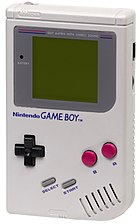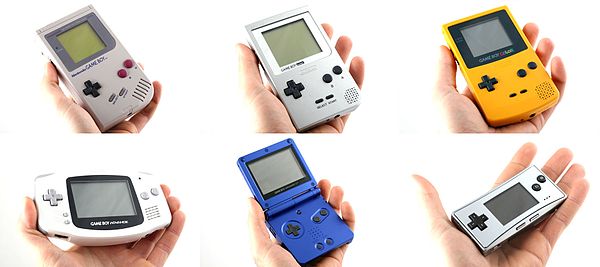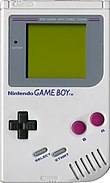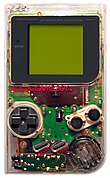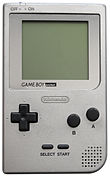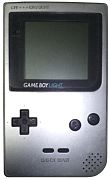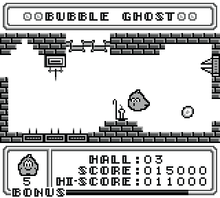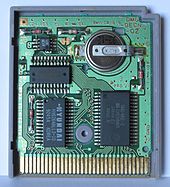Game Boy
| Game Boy | ||||
|---|---|---|---|---|
| Manufacturer | Nintendo | |||
| Type | Handheld console | |||
| generation | fourth generation of consoles | |||
| publication |
|
|||
| Storage media | Modules | |||
| Online service | none | |||
| Units sold | over 118.69 million (including Game Boy Color) | |||
| Most successful game | Tetris (35 million units sold) | |||
| predecessor | Game & Watch | |||
| successor | Game Boy Advance | |||
The Game Boy ( Japanese. ゲ ー ム ボ ー イ , Hepburn : Gēmu Bōi ) is an 8-bit handheld console of the fourth generation developed by Gunpei Yokoi and released by Nintendo on April 21, 1989 in Japan at a price of 10242 yen . It was first presented to the public in 1989. With more than 118.69 million units sold (including Game Boy Color ), the Game Boy is one of the best-selling game consoles and has long been the best-selling handheld console in the world. However, this sales record was broken by the Nintendo DS, which sold around 154.01 million devices.
At first the Game Boy was only available together with the game Tetris , which became the best-selling computer game in history.
history
In 1980 the foundations of Game Boys were laid in the " Game & Watch " series, also marketed by Nintendo . The first Game Boy appeared on the market in 1989, and hundreds of different games were made over the following years . Popular games were Tetris and the Donkey Kong , Zelda , Pokémon , Metroid , and Super Mario games. In 1994 Nintendo launched the Super Game Boy , an adapter that enables Game Boy games to be played on TV sets in color on the much more powerful Super Nintendo console . In 1995 the “Play It Loud!” Campaign caused confusion for the Game Boy, but according to Nintendo, “Play It Loud!” Was just an advertising slogan and had nothing to do with supposedly higher volume. In 1996 the Game Boy Pocket appeared , a slightly smaller version of the Game Boy only half as thick with a slightly larger black and white display (the original Game Boy had a greenish display). In 1997, a modified version of the Game Boy Pocket, the Game Boy Light with integrated background lighting, appeared in Japan .
In 1998 the Game Boy was replaced by the Game Boy Color , which, almost nine years after the appearance of the Atari Lynx, made color display possible for the first time on a Nintendo handheld. In 2001 the Game Boy Advance appeared with the hardware being completely overhauled for the first time and a further improved color screen. In 2003, the foldable version of the Game Boy Advance, the Game Boy Advance SP with additional front lighting and an integrated lithium-ion battery, was introduced. In 2004, the Nintendo DS appeared initially only in Japan and the USA - in 2005 also in Europe . Although the device is backwards compatible with Game Boy Advance modules, it is not a Game Boy successor, but rather, according to Nintendo, should exist alongside the Game Boy line. In 2005, the Game Boy Micro, a very small version of the Game Boy Advance, came onto the market. In the same year, the Game Boy Advance SP appeared in North America with an improved background lighting, which corresponds to the lighting of the Game Boy Micro. In 2006 the Nintendo DS Lite appeared , a slightly smaller version of the Nintendo DS with an improved display.
Models
Game Boy
The ancestor of the series called Game Boy ( colloquially also called Game Boy Classic ) appeared in 1989 and was only available together with the game Tetris at the start of sales. Mainly because of the comparatively weak processor and the black-and-white screen, he initially faced many skeptics. A small size for this time, low costs and economical battery consumption turned out to be decisive advantages over the competing consoles such as the Sega Game Gear and Atari Lynx . You could also purchase a rechargeable battery.
Game Boy Special Edition
In 1995 the original Game Boy was reissued under the name Special Edition . It was technically identical to the Game Boy Classic, but initially available in six different housing colors (red, yellow, green, black, white, transparent), later also in blue, and was delivered with a transport box in which the device, four Spare batteries and up to five games in sleeves fit.
Game Boy Pocket
The Game Boy Pocket from 1996 has the same features as the normal Game Boy. However, it is significantly smaller, is silver-colored as standard and is powered by two AAA batteries. The LC display is also more contrasty. The link cable port has been made smaller to accommodate the new housing. With a new link cable that came with an adapter, playing between the old Game Boy and the Game Boy Pocket was still possible. The first copies of the Game Boy Pocket did not have a battery level indicator; this came later.
The word "pocket" (English for pocket ) points to the compact design.
Game Boy Light
The Game Boy Light is based on the Game Boy Pocket. However, it is slightly larger and has a switchable green backlight. It has the sharpest display of any monochrome game boy. The Game Boy Light requires two AA batteries with which it achieves the same operating time as the Game Boy Pocket despite the backlight being switched on. The standard version of the Game Boy Light appeared in the colors gold and silver. Later, a transparent version, limited to 5000 pieces, was offered with Skeleton . After the Pokémon euphoria began, Nintendo also released the Game Boy Light in a yellow Pikachu special edition.
The Game Boy Light was sold exclusively in Japan from 1997.
Game Boy Color
The Game Boy Color appeared in 1998 as an indirect successor to the Game Boy and the Game Boy Pocket. It is technically based on the first Game Boy line (Z80 generation). The Game Boy Color was the first portable Nintendo game console to have a color screen and was able to display 56 simultaneously from a palette of 32,768 colors. The predecessors still had a display with four shades of gray. The Game Boy Color converts these to black, blue, red and yellow (and white as a background) in this order, which is why the Game Boy Color is also compatible with all Game Boy games without color; this technique is used for color generation up to the Game Boy Advance .
The shape of the case has only been changed slightly and its thickness lies between the Game Boy and the Game Boy Pocket. An infrared interface was new , with which you can play some games against other players without a link cable. With the right module (e.g. Mission: Impossible ) it is possible to turn the Game Boy Color into a remote control for other electronic devices thanks to the infrared interface. Often, however, it was only used to transmit smaller amounts of game data, such as high scores .
The Game Boy Color is backwards compatible with its predecessors. The plug-in modules of the games released for the original device and the Game Boy Pocket can be used. The black-and-white graphic is displayed in a selectable 4-color graphic. The Game Boy Color is available in the colors blue, red, green, yellow, light green, turquoise, purple, purple-transparent, white-transparent, as well as in a limited yellow Pokémon edition.
The game modules for the Game Boy Color were new. The black modules, which were similar to the gray standard modules, could be played on older Game Boy consoles, but without color. In some games, such as Zelda DX , some functions could not be used. There were also new, transparent modules that are only intended for the Game Boy Color and are labeled "Only for Game Boy Color". If you plug these modules z. B. in a Game Boy Pocket or Super Game Boy , only an error message appears.
Games for the Game Boy can, similar to the Super Game Boy for the SNES , be played in color with the Game Boy Color. There is also the option of selecting a palette using a key combination on the device's start screen. The games often had a standard palette more or less adapted to the game. Usually one color row was used for the background and one for the moving elements, sometimes other colors for opponents. Overall, the possibilities for this extended to four to ten colors. The original greyscale palette can be activated by pressing the left control pad + B button.
Game Boy Advance
The Game Boy Advance , working title "Project Atlantis", was the first model in the Game Boy line that was not based on the technology of the original Game Boy. As the successor to the Game Boy Color, this console had a 32-bit ARM RISC processor and a color display, which is why it was also known as the pocket-sized Super Nintendo Entertainment System . An operating time of around 15 hours is achieved with two AA batteries. The Game Boy Advance was released in Japan on March 21, 2001, in North America on June 11, and in Europe and Australia on June 22 of the same year. In the People's Republic of China (except Hong Kong ), the device appeared a few years later, on June 8, 2004. Due to the unexpected success of Pokémon and the feared high starting price of the console, it was decided to use the Game Boy Color as the color version of the Game Boy Pocket to publish.
Game Boy Advance SP
With the Game Boy Advance SP , the Game Boy Advance has been redesigned for convenience. The Game Boy Advance SP can be opened and has lighting that allows games to be played in the dark. Initially, a frontlight (lighting from the front) was used, later there were fewer devices with backlighting . Unlike the Game Boy Advance, it has a built-in lithium-ion battery, which has been standard in Nintendo's handheld consoles ever since. This enables operation for around ten hours. The design was later adopted and improved upon in the production of the Nintendo DS.
Despite fundamental hardware changes , both representatives of the Game Boy Advance generation are downward compatible, so that all Game Boy games can run on them. However, the old link cable is required for multiplayer games between Game Boy and Game Boy Color games, as the Game Boy Advance link cable only works with Game Boy Advance games.
Both Game Boy Advance and SP models were produced in many different colors.
Game Boy Micro
As a new version of the Game Boy Advance, the smallest Game Boy to date (dimensions: 10 cm × 5 cm × 1.8 cm) was released in autumn 2005. The hardware installed is identical to the Game Boy Advance and the Game Boy Advance SP. The Game Boy Micro is only compatible with Game Boy Advance games, however, as the Game Boy Color parts no longer had any space and software emulation was out of the question. It was abandoned by Nintendo shortly afterwards due to low sales. The reason for this was probably the small size and the lack of backward compatibility, even though it had the sharpest display of all Game Boys. In Japan, the Game Boy Micro was marketed as a media player together with Nintendo's multimedia player PlayYan , but this did not bring the expected sales. Since its appearance and size match modern standards well, it is now a sought-after collector's item and achieves prices that are as high as the last new sale price.
There were a handful of special editions available exclusively in Japan, e. B. the " Final Fantasy IV " edition and the Famicom edition.
hardware
- The technical details of the classic Game Boy
- Manufacturer: Nintendo
- Year of publication: 1989
- CPU : 8-bit CMOS; 4.19 MHz clock frequency or 2.097 MHz cycle frequency
- Memory: 8 kB RAM ; 8 kB graphics memory ,
- Sound: 4-channel stereo sound + 1 external channel
- Screen: LCD ; Size: 4.7 × 4.3 cm / 1.9 × 1.7 inches (6.4 cm / 2.6 inches screen diagonal ); Resolution : 160 × 144 pixels; 4 gray levels; Frame rate : approx. 59.7 Hz
- Sprites : 8 × 8 pixels or 8 × 16 pixels, maximum 40 pieces
- Power supply: 4 Mignon batteries, plug-in power supply unit 6 V ⎓ / 120 mA (available separately)
- Dimensions (H × W × D): 148 mm × 90 mm × 32 mm
- Weight: approx. 300 g including batteries
- Country of manufacture: Japan , later People's Republic of China
- The technical details of the Game Boy Color
- Manufacturer: Nintendo
- Release year: 1998
- CPU: 8 bits; 4 and 8 MHz clock frequency
- Memory: 32 kB RAM and 16 kB video RAM
- Sound: 4-channel FM stereo sound + 1 external channel
- Screen: LCD; Size: 4.4 × 4 cm / 1.7 × 1.6 inches (6 cm / 2.3 inches screen diagonal); Resolution: 160 × 144 pixels; 10, 32 or 56 colors from a palette of 32,768 colors can be displayed simultaneously on the screen; Refresh rate: approx. 59.7 Hz
- Power supply: 2 AA batteries; also possible with a separate AC adapter
- Dimensions (H × W × D): 133 mm × 75 mm × 27 mm
- Country of manufacture: Japan , later People's Republic of China
- Devices sold: approx. 49.3 million
- Number of available games: approx. 1200
An unlit black and green LC screen, a directional pad that supports eight directions, and four control buttons , as on the NES with "A", "B", "SELECT" and "START", and a mono speaker are the features of externally visible components . The function of the control buttons depends on the game. In most cases, "START" has a pause function, in menus "A" is generally used to confirm and "B" to cancel.
At the bottom there is a 3.5 mm headphone jack with a stereo output. On the right side there is also a volume control, on the left one for the contrast. The on-off switch is located on top of the front side of the device next to the slot for the ROM - cartridges that also Game Paks are called.
The Game Boy can be connected to another Game Boy via a connection on the side ( Game Link dialogue cable ), which allows multiplayer games for two people if the game supports this. The Game Boy can also be connected to up to three other Game Boys using an optionally available 4-player adapter . On the other hand, there is a power connector to which a power supply can be connected. In the course of time numerous accessories appeared, such as magnifying glasses for the screen, lamps, a Game Boy camera or a Game Boy printer .
software
Basically, the Game Boy is for games designed, but it is also possible, with special programs such as Carillon , LSDJ , Music Box , Nanoloop , Pocket Music etc. ( Chiptune - to music) compose . Some musicians use the Game Boy at their concerts. In order to prevent the playing of software not licensed by Nintendo, the Game Boy had a CPU-internal bootloader as protection. The Nintendo logo is displayed when a licensed game is started. As soon as the logo has reached the center of the screen, the CPU-internal bootloader compares the logo on the game module with the internally saved Nintendo logo. Since the protection is based on the use of the trademarked Nintendo logo, its use for a non-licensed product would have given the console manufacturer the opportunity to sue the respective provider for the unauthorized use of the logo. The British developer Argonaut Software managed to bypass the logo protection, because the bootloader read the logo again from the game module before the comparison. Argonaut and Nintendo entered into a business relationship that led to the development of the 3D add-on chip Super FX for the Super Nintendo Entertainment System.
In Japan, Nintendo launched the PlayYan, a module for the Game Boy Advance, which can be used to display and play files in MP3 , MPEG-4 and DivX formats. However, you cannot compose your own music with him. The PlayYan was also sold outside of Japan as a Game Boy MP3 player without the video function .
The Game Boy can also be used for simple measurement and control tasks. For this purpose, special plug-in modules must be built and your own programs must be written. There are also some special modules u. a. for autotuning, for measuring blood glucose or for controlling sewing machines.
emulation
As the first, direct emulation of the Game Boy hardware, the Super Game Boy was offered from 1994. This is a SNES module into which a Game Boy module is plugged. In this way, it is possible to play Game Boy games in color through the SNES. The Super Game Boy or the Japan-exclusive Super Game Boy 2 is not an actual emulator in the sense of a software emulator because it has components of the handheld console on the circuit board. The performance of the SNES is only required for the additional effects.
Nintendo later launched the Game Boy Player for the GameCube , with which it was also possible to play Game Boy Color and Game Boy Advance games.
Programs such as VisualBoyAdvance have been developed to emulate the Game Boy on a PC . These emulators are used by game programmers to test their simple Game Boy applications, such as Game Boy watches or homebrew games. However, the emulators are also used for copyrighted games that are illegally distributed via websites and file sharing networks.
Successor to the Game Boy series
The Nintendo DS (Dual Screen) was originally marketed in parallel to the Game Boy Advance, but from then on the developers preferred it to the Game Boy Advance. The DS has a touchscreen , a built-in microphone and a WLAN adapter z. B. for online multiplayer. This platform is only downwardly compatible with Game Boy Advance games, not with Game Boy Color games. According to Nintendo, the Nintendo DS is not the successor to the Game Boy Advance, but rather a new handheld game. It does not belong to the actual Game Boy series.
literature
- David Sheff: Nintendo - Game Boy ; Goldmann, M., 1993, ISBN 3-442-30600-0 .
- Michael S. Mühlhaus: Measuring and controlling with the Game Boy , Franzis, 2003, ISBN 3-7723-4205-1 .
- Seppatoni: Game Boy Games Guide ; lulu.de, 2007.
Web links
- Game Boy Land - German-language website about the classic Game Boy
- neXGam - many specials & reviews about the Game Boy
- neXGam - many specials & reviews about the Game Boy Color
- PlanetGameboy.de - German online magazine for the Game Boy Advance
Individual evidence
- ↑ a b c IR Information: Sales Data - Dedicated Video Game Sales Units. In: Nintendo Co., Ltd. Retrieved on August 19, 2019 .
- ↑ Top 10 Most Successful Game Boy Games of All Time. April 23, 2019, accessed August 6, 2020 .
- ↑ Damien McFerran: The Making of Gameboy. (PDF; 2.5 MB) In: Issue. Retro Gamer Magazine, pp. 42-47 , accessed January 30, 2011 (English).
- ↑ Feature: The Making of the Nintendo Game Boy - Damien Mcferran (English)
- ↑ a b c d e f g h Stephan Freundorfer : Special: Review: Nintendo Game Boy. In: gamepro.de. IDG, January 19, 2014, accessed April 28, 2014 .
- ↑ a b c d Evan Amos: Game Boy Manual. Nintendo of America, accessed April 30, 2014 .
- ↑ a b c Technical data. Retrieved on February 29, 2020 (German).
- ↑ a b TASVideos / Platform Framerates. Retrieved February 29, 2020 .
- ↑ Nanoloop. Retrieved March 11, 2015 .
- ↑ YouTube - Gameboy. Retrieved March 11, 2015 .
- ↑ Damien McFerran: Born slippy: the making of Star Fox. June 22, 2014, accessed August 19, 2019 .
- ↑ IGN - PlayYan. IGN, accessed March 11, 2015 .
- ↑ diabetsinfo.de. Retrieved March 11, 2015 .
